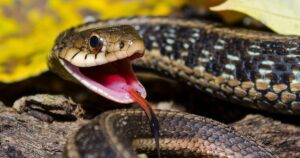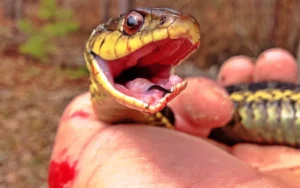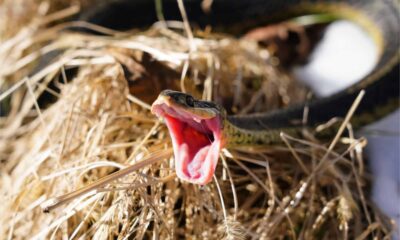Do garter snakes have fangs? Garter snakes are among the most common snakes found in North America. With their distinctive patterns and relatively small size, they often make their way into gardens and yards, sparking curiosity and sometimes concern.
No, garter snakes do not have fangs. Instead, they have small, rear-facing teeth located towards the back of their mouths. These teeth are used for gripping and holding onto prey, rather than injecting venom like fangs found in venomous snakes. Garter snakes are not venomous and are harmless to humans.
Garter Snake Dental Anatomy

Garter snakes, like other colubrid snakes, have a unique dental anatomy adapted for their feeding habits. While they lack the fangs and venom glands found in venomous snakes, they still possess specialized teeth that help them capture, hold, and consume their prey. Here’s a closer look at the dental anatomy of garter snakes:
Types of Teeth in Garter Snakes:
- Maxillary Teeth:
- Located along the upper jaw, these teeth are curved backward (recurved).
- They are used to grasp and hold onto prey, aiding in the initial capture.
- Palatine Teeth:
- Found on the roof of the mouth (palate).
- These teeth assist in manipulating and positioning the prey further back into the snake’s throat during swallowing.
- Pterygoid Teeth:
- Situated on the pterygoid bones, which are part of the upper jaw.
- They play a role in guiding the prey deeper into the snake’s mouth as it is being swallowed.
- Dentary Teeth:
- Located along the lower jaw (dentary bone).
- These teeth work in conjunction with the maxillary teeth to grasp and hold onto prey.
- Retroarticular Teeth:
- Positioned near the back of the mouth, close to the jaw joint (retroarticular process).
- These teeth help prevent prey from escaping as the snake manipulates it into a suitable position for swallowing.
Functions:
- Prey Capture: The recurved teeth on the upper and lower jaws help garter snakes grasp and secure their prey, preventing escape.
- Swallowing: The various types of teeth aid in guiding and positioning the prey deeper into the snake’s mouth and throat during the swallowing process.
- Defense: While not venomous, garter snakes can deliver a bite as a defensive mechanism. The teeth help them grip onto potential threats.
- Digestion: Once swallowed, the teeth assist in holding the prey in place as the digestive process begins.
The dental anatomy of garter snakes reflects their dietary preferences, which primarily consist of small vertebrates, insects, and other invertebrates. Their teeth are not designed for chewing but rather for gripping and holding prey as they swallow it whole.
Do garter snakes have fangs?
Garter snakes do have teeth, but they don’t have fangs like venomous snakes do. Instead, their teeth are relatively small and are located at the back of their mouths. These teeth are used to grasp and hold onto their prey, which mainly consists of small amphibians, insects, and earthworms.
The absence of fangs in garter snakes means that they are not venomous. When a garter snake bites, it typically doesn’t inject venom into its prey or potential threat. Instead, they rely on constriction and their small, rear-facing teeth to help them consume their food.
So, while garter snakes do possess teeth, they do not have fangs or venom glands like some other snake species.
Types of Teeth in Garter Snakes
Garter snakes, like many other snakes, have a variety of teeth specialized for different functions. While they lack fangs and venom glands, they still have several types of teeth adapted for capturing, holding, and consuming their prey. Here are the types of teeth you can find in garter snakes:
- Maxillary Teeth: These are the primary teeth located along the upper jaw. They are curved backward to help grip and hold onto prey.
- Palatine Teeth: Found on the roof of the mouth, these teeth assist in manipulating and moving prey further back into the snake’s throat.
- Pterygoid Teeth: These teeth are located on the pterygoid bones, which are also part of the upper jaw. They play a role in guiding prey deeper into the snake’s mouth during swallowing.
- Dentary Teeth: Situated along the lower jaw, dentary teeth work in tandem with the maxillary teeth to grasp and hold prey while the snake positions it for swallowing.
- Retroarticular Teeth: These teeth are located near the back of the mouth, close to the jaw joint. They help prevent prey from escaping as the snake manipulates it into a suitable position for swallowing.
These various types of teeth allow garter snakes to effectively capture, restrain, and consume their prey, which mainly consists of small vertebrates, insects, and other invertebrates. The teeth are not used for chewing food; instead, garter snakes swallow their prey whole, aided by the backward-pointing orientation of their teeth and their flexible jaws.
Fangs in Garter Snakes

Garter snakes do not possess fangs like those found in venomous snakes. Instead, they have rows of small, recurved teeth located at the back of their mouths. These teeth are designed to grasp and secure their prey, aiding in swallowing rather than injecting venom.
The absence of fangs in garter snakes indicates that they are non-venomous. When a garter snake bites, it typically relies on constriction and its specialized teeth to hold onto its prey or deter potential threats.
So, while garter snakes do have teeth, including specialized ones for capturing and consuming prey, they do not have fangs or venom glands. Their dental structure reflects their feeding habits, which primarily consist of consuming small vertebrates, insects, and other invertebrates.

